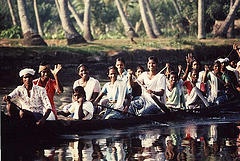Newly published in PLOS Biology is our work identifying genes that confer resistance to common and last-resort antibiotics in bacteria that cause tuberculosis. Resistance to these drugs contributes to mortality and sickness on a pandemic scale every year, and disproportionately affects the poorest people in the world.
This new article is one of a series presenting results generated by more than 100 scientists across 23 countries across 5+ years as part of a collaboration called CRyPTIC.
Our role in CRyPTIC was the discovery of genes and mutations likely to cause drug resistance by applying a tool known as a genome-wide association study (GWAS), an approach we helped adapt to bacteria.
Using GWAS, we identified previously uncatalogued genes and mutations underlying resistance to every one of the 13 drugs we investigated. These include new and repurposed drugs, as well as the first- and second-line drugs more often used to treat tuberculosis.
Thanks to its generous funders, CRyPTIC dedicated scale (10,000+ genomes) and technical innovation (new high-throughput MIC assays) to help decode the DNA blueprint of antibiotic resistance. Pushing these boundaries has yielded a steep increase of up to 36% in the variation in resistance attributable to the genome for the important and previously understudied new and repurposed drugs.
Science at this scale can produce a seemingly overwhelming wealth of new information. We avoided the temptation to over-emphasize any individual result for the sake of simple narrative. Instead, we highlighted discoveries of uncatalogued genes or genetic variants that we found for every drug investigated:
• The amidase AmiA2 and GTPase Era for bedaquiline.
• The cytochrome P450 enzyme Cyp142 for clofazimine.
• The serine/threonine protein kinase PknH for delaminid.
• The antitoxin VapB20 for linezolid.
• The PPE-motif family outer membrane protein PPE42 for amikacin and kanamycin.
• The antibiotic-induced transcriptional regulator WhiB7 for ethionamide.
• The rRNA methylase TlyA for levofloxacin.
• The DNA gyrase subunit B GyrB for moxifloxacin.
• The putative rhodaneses CysA2 and CysA3 for rifabutin.
• The tRNA/rRNA methylase SpoU for ethambutol and rifampicin.
• The multidrug efflux transport system repressor Rv1219 for isoniazid.
All these hits passed stringent evidence thresholds that take into account the large amount of data crunched. For each hit, we identified possible relationships between gene functions, such as they are known, and the mechanism of action of the antibiotics.
Beyond the biological discoveries of primary interest, this new paper unveils methodological advances in bacterial GWAS. We introduced a systematic, whole-genome approach to analysing not just short DNA sequences (so called oligonucleotide or “kmer”-based approaches), but also short sequences of the proteins that the DNA codes for (an oligopeptide-based approach). We have released our software on an open-source GitHub repository.
We also discovered a relationship that may help disentangle a technical issue in bacterial GWAS where the co-occurence of traits can trick us into thinking that a gene influences one trait when it influences another instead. For antimicrobial resistance, this issue is known as artefactual cross resistance. We observed that true associations tended to produce larger associations (as measured by the 'coefficient', rather than the p-value), providing a possible way to prioritize signals in the future.
This paper was published alongside the CRyPTIC Data Compendium in PLOS Biology, in which we released our data open source to the community, with resources provided by the European Bioinformatics Institute.
Some of the results of CRyPTIC have already been rushed into service by the World Health Organization on the grounds of exceptional importance based on a candidate gene approach; this includes the DNA gyrase subunit B – moxifloxacin association spotlighted above (Walker et al 2022). However, the new results go beyond a candidate gene approach, detecting a range of previously uncatalogued genes via its agnostic, whole-genome strategy.
Unpicking the genetics of antimicrobial resistance is a priority for improving rapid susceptibility tests for individual patients, selecting drug regimens that inhibit the evolution of multidrug resistance, and developing improved treatment options. The need is particularly great in M. tuberculosis, which killed 1.4 million people in 2019, owing to the slow (6-12 week) turnaround of traditional susceptibility testing, and the alarming threat of multidrug resistant tuberculosis. The discovery of many new candidate resistance variants therefore represents an advance that we hope will contribute to progress in reducing the burden of disease.


